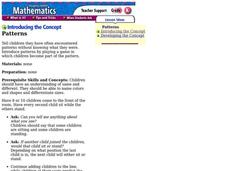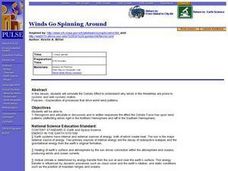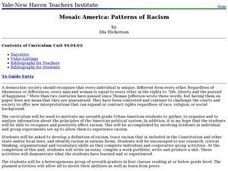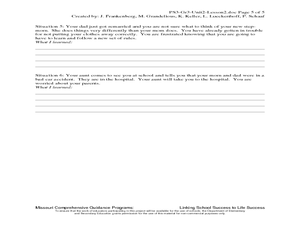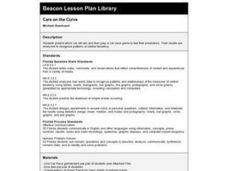Curated OER
Number Patterns in Everyday Life
Examine scenarios involving number patterns. Learners complete a series of activities, including working with Pascal's triangle ando completing chart activities based on different pricing for pizza toppings. An included extension has...
Curated OER
Let's Explore Patterns
Second graders define the word pattern and other related vocabulary. They create a pattern independently. Students recognize and extend patterns. They explain how repeated patterns are made. Students explore several patterns on a...
Curated OER
Mother Nature Pattern Maker
Young scholars in a teacher education program enhance their awareness of patterns. They discover how to support their students in developing this skill in mathematical terms. They role play the role of a K-2 student and collect images...
Curated OER
"Name Those Vowels"
Help your class recognize the capital and lower-case forms of the five vowels. They will learn how to make capital and lower-case forms of the vowels and all the rules surrounding vowels. Fun songs and activities are included. Links to...
Curated OER
Dancing Number Sentences
Learners explore how dance can be infused with mathematics. In this art and mathematics lesson, students recognize how the ABA dance form is similar to a math number sentence. Learners create a dance choosing dance words to represent...
Curated OER
Patterns
Students make patterns. In this early sequencing lesson, students observe and state a pattern when they see one. The teacher begins be using students to demonstrate a pattern with half of the children standing and every other child sitting.
Curated OER
Winds Go Spinning Around
High schoolers simulate the Coriolis Effect to comprehend why winds in the Westerlies are prone to cyclonic and anti-cyclonic motion. They arrive at an explanation of processes that drive world wind patterns
Curated OER
Mosaic America: Patterns of Racism
Seventh graders use print and electronic resources to gather and analyze information on the political system in the United States. Using the Constitution, they identify and discuss instances of racism included in amendments and laws. ...
Curated OER
Periodic Table Patterns using Fabulous Periodic
Learners explain how elements are arranged in the periodic table. In this chemistry lesson, students group the eggs according to a certain pattern. They compare this to elements in the periodic table.
Curated OER
Tic Tac Toe Do's and Don'ts
Fourth graders listen as the counselor reads statements. They receive a tic-tac-toe worksheet and complete it with two different color crayons. Students look at the overhead projector and check their tic-tac-toe game card. They discuss...
Curated OER
What to do? What to do? Part Two
Third graders perform skits and note ideas fro problem solving in various situations. In this coping instructional activity, 3rd graders role play problem solving and coping in life-changing situations based on "What to Do" solution...
Curated OER
Cars on the Curve
Second graders, using two dice, participate in a car race game called Cars on the Curve. They predict which car wins the game and records it in their Data Diary.
Curated OER
Earthquakes and Plate Tectonics
Students research about earthquakes that took place within a certain distance from their place. In this geology lesson, students explain why earthquakes occur. They analyze patterns of different earthquakes using a computer program.
Curated OER
Underwater Hide and Seek
High schoolers explain why color patterns that are easy to see above water may be difficult to detect under water and experience the problems predators face when searching for camouflaged prey.
Curated OER
El Nino
Students recognize that El Nino is caused by changes in the atmospheric and ocean content. They conduct a simple experiment, visit websites and create a class poster using individual storyboards.
Curated OER
Let's Play Scrabble!
What do Alfred Mosher Butts, James Brunot, and Jack Straus have in common? They were all instrumental in the development of Scrabble. Class members will discover these facts and many more as they conduct a WebQuest to gather, organize,...
Curated OER
A Trip to the Toy Store
First graders recognize and identify the value of a penny, nickel and dime. They spend play money in a simulated toy store and match their coins to the purchase price of a toy of their choice.
Curated OER
Telling Time to 5 Minutes
Students take part in various activities ranging from creating a human clock, to small group problem solving to reinforce the concept of telling time accurately to five minutes on an analog clock.
Orange County Department of Education
Pepita Talks Twice
Third graders read Pepita Talks Twice and define the character traits of respect and responsibility. They write their examples of the characters traits on a character trait doll. Students recognize the character traits of respect and...
Curated OER
I Know What You Did this Summer
Students discuss the characteristics of a quality relationship and determine how such a relationship is maintained. After reading a scenario of a relationship, students take one character at a time and place themselves in the character's...
Curated OER
Change Mixer
Students use their abilities to recognize coins and their values in this game that focuses on locomotor skills (skip, slide, gallop, run, jump). This game also requires students to add coin values.
Curated OER
Overarm throw/striking for force
Students practice overarm throw/stricking pattern, particularly: opposition in the legs, increased trunk rotation, preparatory back swing, and uncoiling of trunk, humerous and forearm.
Curated OER
Sieve of Eratosthenes
Learners discover the Sieve of Erathosthenes. They explore a method to find all the prime numbers in a group of numbers. Using models, students practice divisibility rules while examining the difference between prime and composite numbers.
Curated OER
Tootsie Roll, Tootsie Roll, Who Art Thou?
Learners discuss gender role stereotyping and males and females in non-traditional work roles. They debate and discuss opinions as a group, and then as a class, concerning "men only" and "women only" jobs





